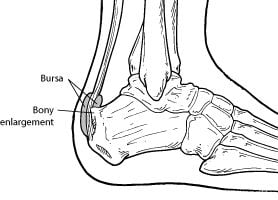What Is Haglund's Deformity?
 Haglund’s deformity is a bony enlargement on the back of the heel. The soft tissue near the Achilles tendon becomes irritated when the bony enlargement rubs against shoes. This often leads to painful bursitis, which is an inflammation of the bursa (a fluid-filled sac between the tendon and bone).
Haglund’s deformity is a bony enlargement on the back of the heel. The soft tissue near the Achilles tendon becomes irritated when the bony enlargement rubs against shoes. This often leads to painful bursitis, which is an inflammation of the bursa (a fluid-filled sac between the tendon and bone).
Causes
Haglund’s deformity is often called “pump bump” because the rigid backs of pump-style shoes can create pressure that aggravates the enlargement when walking. In fact, any shoes with a rigid back, such as ice skates, men’s dress shoes, or women’s pumps, can cause this irritation.
To some extent, heredity plays a role in Haglund’s deformity. Inherited foot structures that can make one prone to developing this condition include:
- A high-arched foot
- A tight Achilles tendon
- A tendency to walk on the outside of the heel.
Symptoms
Haglund’s deformity can occur in one or both feet. The symptoms include:
- A noticeable bump on the back of the heel
- Pain in the area where the Achilles tendon attaches to the heel
- Swelling in the back of the heel
- Redness near the inflamed tissue
Diagnosis
After evaluating the patient’s symptoms, the foot and ankle surgeon will examine the foot. In addition, x-rays will be ordered to help the surgeon evaluate the structure of the heel bone.
Non-Surgical Treatment
Non-surgical treatment of Haglund’s deformity is aimed at reducing the inflammation of the bursa. While these approaches can resolve the pain and inflammation, they will not shrink the bony protrusion. Non-surgical treatment can include one or more of the following:
- Medication. Oral nonsteroidal anti-inflammatory drugs (NSAIDs), such as ibuprofen, may be recommended to reduce the pain and inflammation.
- Ice. To reduce swelling, apply an ice pack to the inflamed area, placing a thin towel between the ice and the skin. Use ice for 20 minutes and then wait at least 40 minutes before icing again.
- Exercises. Stretching exercises help relieve tension from the Achilles tendon. These exercises are especially important for the patient who has a tight heel cord.
- Heel lifts. Patients with high arches may find that heel lifts placed inside the shoe decrease the pressure on the heel.
- Heel pads. Pads placed inside the shoe cushion the heel and may help reduce irritation when walking.
- Shoe modification. Backless or soft backed shoes help avoid or minimize irritation.
- Physical therapy. Physical therapy modalities, such as ultrasound, can help to reduce inflammation.
- Orthotic devices. Custom arch supports control the motion in the foot.
- Immobilization. In some cases, casting may be necessary.
When Is Surgery Needed?
If non-surgical treatment fails to provide adequate pain relief, surgery may be needed. The foot and ankle surgeon will determine the procedure that is best suited to your case. It is important to follow the surgeon’s instructions for post-surgical care.
Prevention
A recurrence of Haglund’s deformity may be prevented by:
- Wearing appropriate shoes; avoid shoes with a rigid heel back
- Using arch supports or orthotic devices
- Performing stretching exercises to prevent the Achilles tendon from tightening
- Avoiding running on hard surfaces and running uphill.
Our Locations
Find us on the map
Hours of Operation
Our Regular Schedule
Milford Podiatry Associates, P.C.
Monday:
8:30 am-5:00 pm
Tuesday:
8:30 am-5:00 pm
Wednesday:
8:30 am-5:00 pm
Thursday:
8:30 am-5:00 pm
Friday:
8:30 am-5:00 pm
Saturday:
8:30 am-12:30 pm
Sunday:
Closed
